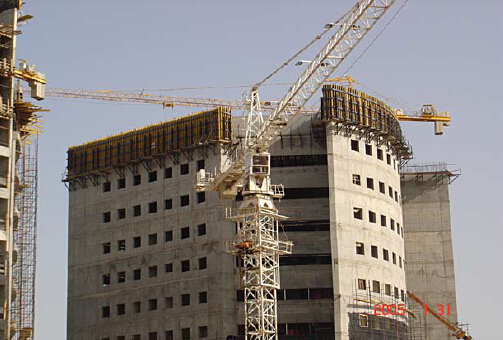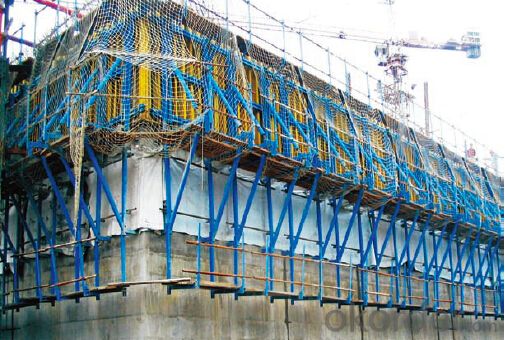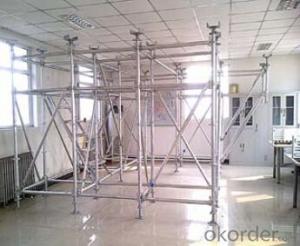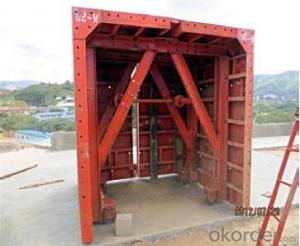Single-side Climbing Bracket SCB40 for formwork and scaffolding systems
- Loading Port:
- Tianjin
- Payment Terms:
- TT OR LC
- Min Order Qty:
- 50 m²
- Supply Capability:
- 1000 m²/month
OKorder Service Pledge
OKorder Financial Service
You Might Also Like
Single-side Climbing Bracket SCB180:
With CNBM SCB 180 climbing systems, the loads from the fresh concrete pressure are
transferred through the brackets by means of V-strongbacks and compression braces into the
scaffold anchors.
Typical applications for the SCB 180 are dams, locks, cooling towers, pier heads, tunnels, and
bank vaults.
The formwork is simply tilted backwards when striking takes place. The 1.80 m wide bracket
requires only a minimum of space.
Characteristics:
◆ Economical and safe anchoring
The M30/D20 climbing cones have been designed especially for single-sided concreting using
SCB180 in dam construction, and to allow the transfer of high tensile and shear forces into the still
fresh, unreinforced concrete. Without wall-through tie-rods, finished concrete is perfect.
◆ Stable and cost-effective for high loads
generous bracket spacings allow large-area formwork units with optimal utilization of the bearing
capacity. This leads to extremely economical solutions.
◆ Simple and flexible planning
With SCB180 single-sided climbing formwork, circular structures can also be concreted without
undergoing any large planning process. Even use on inclined walls is feasible without any special
measures because additional concrete loads or lifting forces can be safely transferred into the
structure.


- Q: Can steel formwork be used for both straight and curved concrete elements?
- Yes, steel formwork can be used for both straight and curved concrete elements. Steel formwork is highly versatile and can be easily adapted to different shapes and sizes. It provides a strong and durable framework that can withstand the pressure of the concrete, allowing for the creation of both straight and curved structures.
- Q: Can steel formwork be used for both vertical and horizontal applications?
- Indeed, both vertical and horizontal applications can make use of steel formwork. Renowned for its versatility and strength, steel formwork proves itself suitable for a multitude of construction projects. It serves as an ideal tool for crafting formwork not only for vertical elements such as walls, columns, and beams, but also for horizontal elements like slabs and foundations. Thanks to its inflexible nature, steel formwork guarantees meticulous shaping and ensures the concrete remains securely in place during pouring and curing. Moreover, the reusability of steel formwork renders it an economical option for construction projects necessitating frequent formwork alterations or repetitive utilization.
- Q: Can steel formwork be used for museum construction projects?
- Yes, steel formwork can be used for museum construction projects. Steel formwork is a versatile and durable option for constructing various types of structures, including museums. It offers several advantages such as high strength, adjustable sizes, reusability, and easy assembly and disassembly. Steel formwork allows for precise and accurate construction, ensuring the quality and integrity of the museum's design. Additionally, steel formwork can withstand the weight of concrete and provide a smooth finish, which is essential for preserving the aesthetic appeal of the museum. Overall, steel formwork is a suitable choice for museum construction projects due to its strength, adaptability, and ability to meet the specific requirements of such projects.
- Q: Can steel formwork be used for precast concrete stairs?
- Yes, steel formwork can be used for precast concrete stairs. Steel formwork is highly durable and can withstand the weight and pressure of the concrete during the casting process. It provides a smooth and uniform finish to the precast concrete stairs, ensuring a high-quality end product. Steel formwork also offers flexibility in terms of customization, allowing for the creation of various designs and dimensions for the precast concrete stairs. Additionally, steel formwork can be reused multiple times, making it a cost-effective option for precast concrete stairs production. Overall, steel formwork is a suitable choice for constructing precast concrete stairs.
- Q: Can steel formwork be used for tunnel portals?
- Tunnel portals can indeed utilize steel formwork. This option proves to be versatile and durable, as it possesses strength and can withstand the forces and pressures exerted by the surrounding soil and rock. Steel formwork can be customized to fit any shape and size needed for tunnel portals, and it can be easily assembled and disassembled, making it a practical choice for tunnel construction. Furthermore, steel formwork ensures a smooth surface finish, which is crucial for tunnel portals as it promotes efficient traffic flow and minimizes the risk of vehicle damage. In summary, steel formwork stands as a suitable and frequently employed method for constructing tunnel portals.
- Q: Can steel formwork be used for high-rise construction projects?
- Yes, steel formwork can be used for high-rise construction projects. Steel formwork is known for its strength and durability, making it suitable for heavy-duty applications such as high-rise construction. It provides excellent stability and support to the concrete during the pouring and curing process, ensuring the structural integrity of the building. Additionally, steel formwork can be easily assembled and disassembled, making it efficient for use in tall structures where multiple floors need to be constructed. Its reusable nature also allows for cost savings in the long run. Overall, steel formwork is a reliable and popular choice for high-rise construction projects.
- Q: What are the different accessories required for steel formwork maintenance?
- The different accessories required for steel formwork maintenance include the following: 1. Formwork cleaning agents: These are used to remove any concrete residue or build-up on the steel formwork. They help in maintaining the smooth surface of the formwork and prevent any damage or corrosion. 2. Formwork release agents: These are applied to the steel formwork before pouring concrete to prevent it from sticking to the formwork. They help in easy removal of the formwork after the concrete has cured. 3. Formwork patching compounds: These are used to repair any damages or imperfections on the steel formwork. They help in maintaining the structural integrity of the formwork and ensure its longevity. 4. Formwork oil or grease: These lubricants are applied to the moving parts of the steel formwork, such as hinges or sliding mechanisms. They help in smooth operation and prevent any friction or wear and tear. 5. Formwork ties and connectors: These are used to secure the formwork panels together and ensure stability during concrete pouring. They should be regularly inspected and replaced if damaged or worn out. 6. Formwork wedges and pins: These are used to align and secure the formwork panels in place. They should be checked regularly to ensure proper positioning and stability. 7. Formwork clamps and brackets: These accessories are used to support and hold the formwork panels in position. They should be inspected for any signs of damage or weakness and replaced if necessary. 8. Formwork cleaning tools: These include brushes, scrapers, and high-pressure washers, which are used to clean the steel formwork. Regular cleaning helps in maintaining the formwork's appearance and prevents the accumulation of dirt or debris. 9. Formwork storage and transportation equipment: These include racks, trolleys, or storage containers, which are used to store and transport the steel formwork safely. Proper storage and transportation ensure the formwork's longevity and prevent any damage or distortion. Overall, the different accessories required for steel formwork maintenance are crucial to ensure the formwork's optimal performance, durability, and safety during concrete construction projects.
- Q: What are the different types of release agents used with steel formwork?
- There exist various release agents that can be utilized with steel formwork. Some of the most frequently encountered types encompass: 1. Water-based release agents: These release agents consist mainly of water, with additives like surfactants and lubricants. They are environmentally friendly and can be easily applied by spraying or brushing onto the steel formwork. By forming a thin film on the steel surface, water-based release agents prevent the concrete from adhering during the curing process. 2. Solvent-based release agents: Organic solvents serve as the carrier for the active ingredients in these release agents. They are effective in providing a smooth surface finish on the concrete and are often employed in situations where a higher level of release performance is required. Application is typically done through spraying or brushing, and the solvents evaporate quickly, leaving a thin film on the steel formwork. 3. Barrier release agents: These release agents are usually applied as a thick paste or gel, creating a physical barrier between the steel formwork and the concrete. They are commonly used when a high-quality surface finish is desired, such as in architectural concrete applications. Brushing or troweling the barrier release agents onto the steel formwork is the typical method of application. 4. Dry release agents: These agents come in powdered or granular form and are directly applied to the steel formwork. They create a non-stick surface by absorbing excess moisture from the concrete, thus preventing adhesion. Dry release agents are often employed in situations where other types of release agents may not be suitable, such as in cold weather conditions. 5. Form release oils: Petroleum-based products, known as form release oils, are frequently used in conjunction with steel formwork. They effectively establish a release barrier between the steel and the concrete, preventing adhesion. Application of form release oils is typically done through spraying or brushing, and they can be utilized in various concrete applications. The selection of the appropriate release agent is crucial and should be based on specific project requirements, including the desired surface finish, environmental considerations, and ease of application. Seeking guidance from professionals or consulting the manufacturer's recommendations can aid in determining the most suitable release agent for a particular steel formwork application.
- Q: How does steel formwork handle different concrete surface gloss levels?
- Steel formwork is an excellent choice for handling different concrete surface gloss levels due to its versatility and durability. The smooth and rigid nature of steel formwork allows it to create a consistent and even surface finish, regardless of the gloss level desired. When it comes to different concrete surface gloss levels, steel formwork offers several advantages. Firstly, it provides a smooth and uniform surface, which is crucial for achieving a high gloss finish. The steel panels are precisely constructed to create a seamless surface, minimizing any irregularities that could affect the gloss level. Additionally, steel formwork is highly resistant to warping or bending under the weight of the concrete, ensuring that the surface remains level and consistent. This is particularly important when aiming for a glossy finish, as any inconsistencies in the formwork could result in uneven concrete placement and subsequent variations in gloss. Furthermore, steel formwork is reusable, making it cost-effective and environmentally friendly. With proper maintenance and care, steel formwork can be used for multiple projects, allowing for consistent results in terms of gloss levels. In conclusion, steel formwork is an ideal choice for handling different concrete surface gloss levels. Its smooth and rigid construction ensures a uniform surface finish, while its durability guarantees consistent results. Steel formwork provides an efficient and effective solution for achieving various gloss levels in concrete construction projects.
- Q: How does steel formwork handle different types of concrete mixes?
- Steel formwork is a versatile and durable option for handling different types of concrete mixes. It is designed to withstand the pressure and weight of various concrete mixes, making it suitable for both regular and specialized applications. Steel formwork has a high load-bearing capacity, allowing it to handle heavy concrete mixes without deforming or collapsing. This is particularly important for concrete mixes with a high water-cement ratio or those containing additives such as admixtures, which can increase the fluidity and weight of the concrete. Moreover, steel formwork is resistant to chemical reactions that can occur between certain concrete mixes and other materials. It can withstand the alkaline nature of concrete, preventing corrosion or degradation over time. This makes it suitable for handling concrete mixes that may have aggressive chemical compositions or contain aggressive substances, such as sulfates or chlorides. Steel formwork also offers flexibility in terms of shape and size. It can be easily customized to accommodate different concrete designs and structures, allowing for the creation of complex shapes and architectural features. This versatility makes steel formwork suitable for handling concrete mixes used in modern construction, where unique and intricate designs are often desired. In addition, steel formwork provides a smooth and consistent finish to the concrete surface. This is particularly beneficial for concrete mixes that require a high-quality finish, such as those used in architectural applications or exposed concrete structures. The smoothness of the steel formwork surface helps in achieving a visually appealing and structurally sound concrete finish. Overall, steel formwork is an ideal choice for handling different types of concrete mixes due to its strength, resistance to chemical reactions, flexibility, and ability to provide a smooth finish. It ensures the integrity and quality of the concrete structure, making it a reliable and efficient solution for construction projects of all sizes and complexities.
Send your message to us
Single-side Climbing Bracket SCB40 for formwork and scaffolding systems
- Loading Port:
- Tianjin
- Payment Terms:
- TT OR LC
- Min Order Qty:
- 50 m²
- Supply Capability:
- 1000 m²/month
OKorder Service Pledge
OKorder Financial Service
Similar products
Hot products
Hot Searches


















